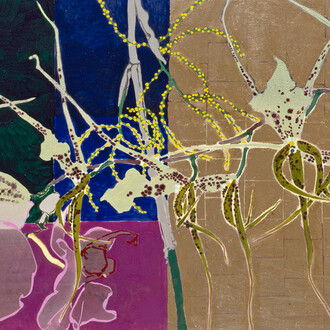With Right Here, Right Now: Houston, the Contemporary Arts Museum Houston showcases artists living in the city and celebrates our region’s vibrant creative community. Houston has been a lively breeding ground for artistic innovation for decades now and is increasingly considered a global art center alongside New York, Los Angeles, London, and more recently, Berlin. The Houston of today is a globally networked city where a manageable cost of living and affordable studio space allows innovators to maintain practices at a highly professional level without having to sacrifice international recognition or an excellent quality of life. Right Here, Right Now: Houston is a dynamic portrait of the artistic developments taking shape in studios across this city and features solo presentations of work by Houston-based artists Debra Barrera, Nathaniel Donnett, and Carrie Marie Schneider. It marks the beginning of an occasional and ongoing series through which the museum will investigate localized artistic practices.
CAMH’s Director Bill Arning, Senior Curator Valerie Cassel Oliver, and Curator Dean Daderko respectively selected Barrera, Donnett, and Schneider. Each artist and curator pair worked together closely from the conception to the installation of the artist’s individual project. A complement of public programs will be presented in conjunction with the exhibition. (Please check CAMH’s online calendar for a complete listing.) Right Here, Right Now: Houston is the first solo museum exhibition for each of the participating artists.
CAMH sees itself as a nexus point for making sure that information on cutting edge culture flows in two directions: into and out of our unique metropolis. Along with CAMH’s recent drawing survey of Houston-based artist Trenton Doyle Hancock and an upcoming Perspectives exhibition of work by Robert Hodge, as well as a survey of the work of Mark Flood slated for 2016, this exhibition will bring work by some of Houston’s most talented art makers to both area audiences for whom their work may be familiar, as well as act as an introduction to wider audiences outside of the region.
Debra Barrera: Avalon
In Avalon, Debra Barrera’s ongoing exploration of the very human desire for escape is explored in drawing, installation, and objects. In her earliest mature works, she focused on modes of transportation combined with cinema—both methods of getting outside of or away from one’s present circumstances. She identifies far way places real and unreal, accessible and impossible, and provides hints of how we can get there from wherever we are. In this installation, drawings of unlikely escapes, such as the puff of smoke the Wicked Witch used to vanish in the Wizard of Oz, are mixed with motorcycle helmets and taxi lights that all but declare “get me out of here.” The installation employs the real exits of CAMH using pink and black, respectively, to make the existing emergency exit and trap door appear to promise alternative escape routes. The title Avalon refers to an imaginary place that derives from our shared mythic histories, which when sung by Bryan Ferry in Roxy Music’s Avalon, was the perfect location for unreal romance.
Nathaniel Donnett: Nothing to See Hear
Nathaniel Donnett’s Nothing to See Hear is an investigation into how sound and light can create a space of remembrance and meditation. Through the use of minimalist gestures, Donnett has created an immersive environment that integrates light, sound, sculpture, and works on paper that give visibility to the contemporary portrayals of resistance and protest, loss and mourning. Donnett pays homage to the numerous men and women who have died while placing themselves on the front line for justice. His installation functions as a visual eulogy to their sacrifice as well as a conscious and thought provoking call toward social awareness.
Carrie Marie Schneider: Incommensurate Mapping
For this exhibition, Carrie Marie Schneider has created architectural models of CAMH that stage a variety of conceptual, social, archival, structural, and imagined possibilities for the Museum. Each model builds on CAMH’s iconic parallelogram footprint, which opened in 1972 and was designed by Gunnar Birkerts, and considers aspects of CAMH’s place within Houston’s broader cultural fabric. With their variety of scales, diverse media, and aesthetic sensibilities, these speculative models “situate the Museum within webs of broader organizational and intellectual concerns to investigate CAMH’s wider cultural function, its place in the city, and the space it provides for art(ists),” says Schneider. Her polyphonic display is “full of possibilities and informed by survival creativity, good humor, desperate imagination, and the political charge to project a future forward. The models operate in the funky overlap where we envision and build a new world while we still occupy this one.”
Right Here, Right Now: Houston will be on view in the Contemporary Arts Museum Houston’s Brown Foundation Gallery from August 23 to November 30, 2014.
















